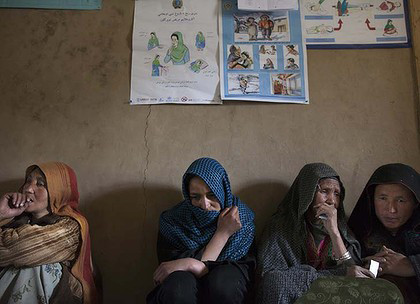Owen Bowcott

The New York Times, Jun. 15, 2011: Women live perilously in many developing countries today, but on top of the list is Afghanistan, the experts said, with one of the highest maternal mortality rates in the world, minimal access to basic health care and education and scarcely any economic rights for women and girls. Eighty-seven percent of Afghan women are illiterate and one in 11 dies in childbirth, Unicef estimates. As many as 8 in 10 face forced marriages. (Photo: Getty Images/Paula Bronstein)
LONDON: Targeted violence against female public officials, dismal healthcare and desperate poverty make Afghanistan the world's most dangerous country in which to be born a woman, a new global survey shows.
The Democratic Republic of Congo, Pakistan, India and Somalia feature in descending order after Afghanistan in the list of the five worst countries, the poll among gender experts shows.
The appearance of India, a country rapidly developing into an economic superpower, was unexpected. It is ranked as hazardous because of the subcontinent's high level of female infanticide and sex trafficking.
Others were less surprised to be on the list. Told of Somalia's inclusion, its Women's Minister, Maryan Qasim, said: ''I thought Somalia would be first on the list, not fifth.''
The survey has been compiled by the Thomson Reuters Foundation to mark the launch of a website, TrustLaw Woman, aimed at providing free legal advice for women's groups around the world.
High maternal mortality rates, limited access to doctors and a ''near total lack of economic rights'' render Afghanistan such a threat to its female inhabitants.
''Continuing conflict, NATO airstrikes and cultural practices combine to make Afghanistan a very dangerous place for women,'' said Antonella Notari, the head of Women Change Makers, a group that supports women social entrepreneurs around the world.
''Women who do attempt to speak out or take on public roles that challenge ingrained gender stereotypes of what is acceptable for women to do or not, such as working as policewomen or news broadcasters, are often intimidated or killed.''
The ''staggering levels of sexual violence'' in the lawless east of the Democratic Republic of Congo account for its second place in the list. One recent US study claimed that more than 400,000 women are raped there each year.
''Rights activists say militia groups and soldiers target all ages, including girls as young as three and elderly women,'' the survey reports.
Pakistan is ranked third on the basis of cultural, tribal and religious practices harmful to women. ''These include acid attacks, child and forced marriage and punishment or retribution by stoning or other physical abuse,'' the poll finds.
The reproductive health adviser at the International HIV/Aids Alliance, Divya Bajpai, said: ''Pakistan has some of the highest rates of dowry murder, so-called honour killings and early marriage.''
Pakistan's human rights commission says about 1000 women and girls die in honour killings annually.
India is the fourth most dangerous country. ''India's central bureau of investigation estimated that in 2009 about 90 per cent of trafficking took place within the country and that there were some 3 million prostitutes, of which about 40 per cent were children,'' the survey finds.
Forced marriage and forced labour trafficking add to the dangers for women. ''Up to 50 million girls are thought to be 'missing' over the past century due to female infanticide and foeticide,'' the UN Population Fund said, because parents prefer to have boys rather than girls.
Somalia suffers high levels of maternal mortality, female genital mutilation and limited access to education and healthcare.
Ms Qasim added: ''The most dangerous thing a woman in Somalia can do is to become pregnant … There are no hospitals, no healthcare, no nothing.
''Add to that the rape cases that happen on a daily basis, and female genital mutilation being done to every single girl in Somalia. Add to that famine and drought. Add to that the fighting [which means] you can die any minute, any day.''
The survey was based on responses from more than 200 specialists chosen for their expertise in gender issues.



